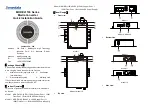
1. Important safety instructions
WARNING
Before you install and use your inverter, be sure to read
and save these safety instructions
General safety precautions
Do not expose the inverter to rain, snow, spray, bilge or dust. To reduce risk of hazards, do not
cover or obstruct the ventilation openings. Do not install the inverter in a zero-clearance
compartment. Overheating may result.
To avoid a risk of fire and electric shock make sure that existing wiring is in good electrical
conditions and the wire size isn´t undersized. Do not operate the inverter with damage or
substandard wiring.
This equipment contains components that tend to produce arcs or sparks. To reduce the risk
of fire or explosion, do not install in a compartment containing batteries or flammable
materials, or in a location that requires ignition protected equipment.
Never smoke or allow a spark or flame in vicinity of battery or engine.
Not installing a fuse can result in fire that may cause injuries and/or damages.
You may observe a spark when making the cable connections since current may flow and
charge capacitors in the inverter. This is normal. Do not make cable connections in the
presence of flammable fumes; it may result in explosion and/or fire.
Shock Hazard. Before proceeding further, carefully check the inverter is
not
connected to any
batteries, and that all wiring is disconnect from any electrical sources. Do not connect the
output terminals of the inverter to an incoming AC source.
2. Where to install
Your inverter should be installed in a location that meets the following requirements:
Dry: keep the inverter away from any water or moisture.
Cool: Ambient air temperature should be between -15ºC y 45ºC (5ºF and 113ºF)
Ventilated: Ensure that the unit is located in a well ventilated compartment. At least 15cm (6
inches) of clearance are required around the inverter for air flow. Verify that all ventilation
openings on the unit (front and rear panels) are not obstructed.
Making DC cable connections:
Your cables should be as short as possible (ideally, less than 3m / 10 feet) and large enough to
handle the required current in accordance with the electrical codes or regulations applicable
to your installation.
User’s manual
- 1 -
PDAxx00S / PDA1000/1800/3000


































